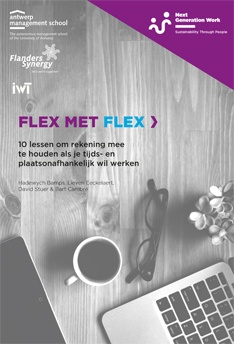
Teleworking, home working, flexdesk work, flexible work arrangements, … are all forms of time- and place-independent work (TPIW). In this Whitepaper, the Competence Center Next Generation Work wants to report what makes TPIW succeed or fail.
You can download the Flex with Flew whitepaper, based on literature research and case studies of Antwerp Management School (only available in Dutch). Based on these findings, an interactive tool was developed: the Flexwork scan.
TPOW is de nieuwe, flexibele manier van werken, waarbij de werknemer zelf kan kiezen wanneer en waar hij werkt. Afhankelijk van de organisatie en de regeling kan dit een win-win situatie betekenen voor beide partijen. Hoewel het tegenwoordig voornamelijk bij hoger opgeleiden voorkomt, zou TPOW voor veel meer werknemers mogelijk zijn. Men durft de impact van deze manier van werken wel eens onderschatten, maar met de veranderende bedrijfswereld kan dit wel eens een noodzakelijke aanpassing zijn.
These are the 10 most important points of interest:
- Start from a vision and make the choice for time- and place-independent work clear: explicitly formulate the reasons why you find TPIW crucial for the company. The vision on TPIW has to be embedded in the broader vision of the organization, in which there should be a correct and clear communication.
- Work completely and multidisciplinary: dealing with the TPIW completely has an impact on the core processes of an organization, so it is necessary to keep the structure, culture, people and systems in mind. Working together between different people and services is essential for this, as well as giving direction, adjusting, educating, etc.
- The explicit support from the top and an adapted way of leading are necessary: even though explicit support from the top may seem obvious, it often is not. When the management and executives act as an example, this motivates the employees. Leading a team from a distance obviously asks for a specific set of competences and central points, such as a good monitoring of, sufficient attention for and a clear communication towards the individual colleagues.
- If you want to go fast, go alone; if you want to go far; go together: involvement is an essential component of sustainable results. Involve the executives and employees with the preparation and do not forget about the social partners. Assigning a group of colleagues as ‘ambassadors’ to support the cause can also lead to success. In this process, there should of course also be attention towards diversity and for those employees who cannot or do not want to participate in TPIW.
- The implementation of TPIW demands continuous attention: it is not a short-term project that can be forgotten. Continuous support, such as education and coaching, is a necessary factor for success. Due to the different ‘rhythms’ of the employees, there will be more distance and less communication. Make sure to plan enough moment in which everyone comes together.
- TPIW requires a customized approach: every company is different, which means that every implementation of TPIW is different as well. In some companies, input between colleagues is more important than in others. Bear this in mind and do not try to carry through large changes suddenly. A customized approach is necessary to make TPIW succeed.
- Create a pleasant work environment and decent working tools: changes on the level of ICT are necessary to make sure that every employee can work decently. Clarify the needs regarding teamwork, communication and information and include the end users early enough in the preparation. Often, the work environment is altered when TPIW is introduced, but this should not be at the expense of those people who work from the office. In the end, do not forget about specific needs of specific functions and do not attach too much importance to fashion and design, because this could be at the expense of comfort.
- Good arrangements make for good friends: due to the reduced contact, the information exchange reduces as well. Properly plan work meetings and prepare them thoroughly. Strive for a good freedom-happiness balance and draw up agreements regarding the reachability. Clarify that TPIW influences the work-life balance positively, but that the importance of the work should remain in the front. Also, do not forget about the juridical level and limit the amount of homeworking or teleworking days.
- Believe in autonomy, trust and result driven working: when implementing TPIW, it is important that everyone knows what is expected of them. Trust and autonomy are essential, so investing in control mechanisms could work counterproductively.
- No Flexible Working[1] without New Organizing: TPIW and Flexible Working (FW) are not exactly the same thing. This last one is a broader concept, based on trust, flexibility and responsibility for colleagues. FW is about giving more responsibility and autonomy to colleagues about creating a new way of working. Management invests in arranged communication, cooperation and coordination. One has to differentiate in this: not every team needs the same kind of support.
[1] Nl.: Het Nieuwe Werken (HNW)
Download the white paper here and click here to go to the Flexworkscan


